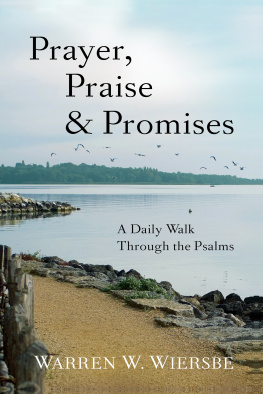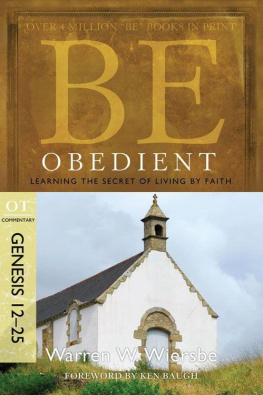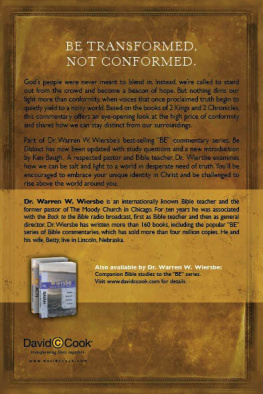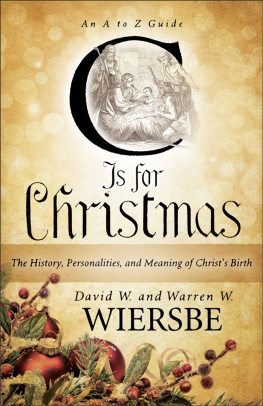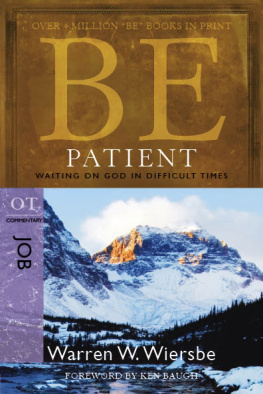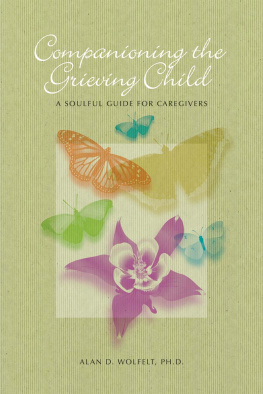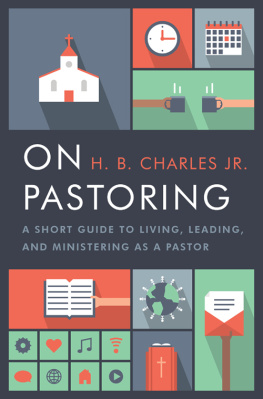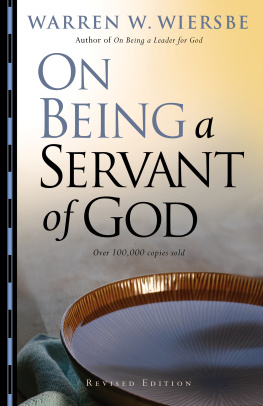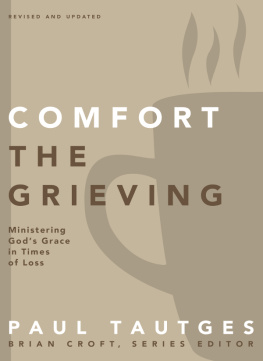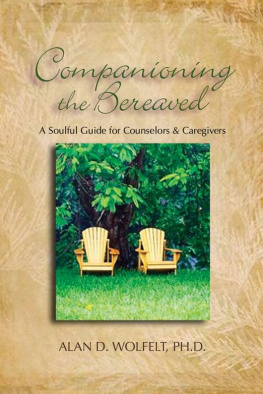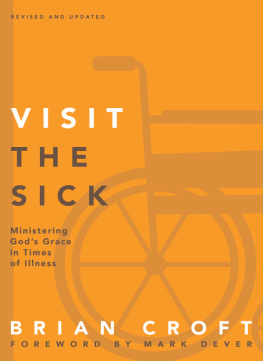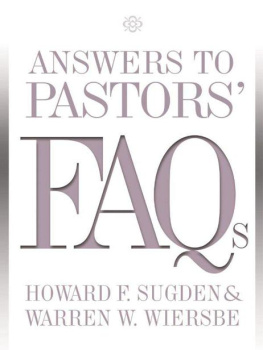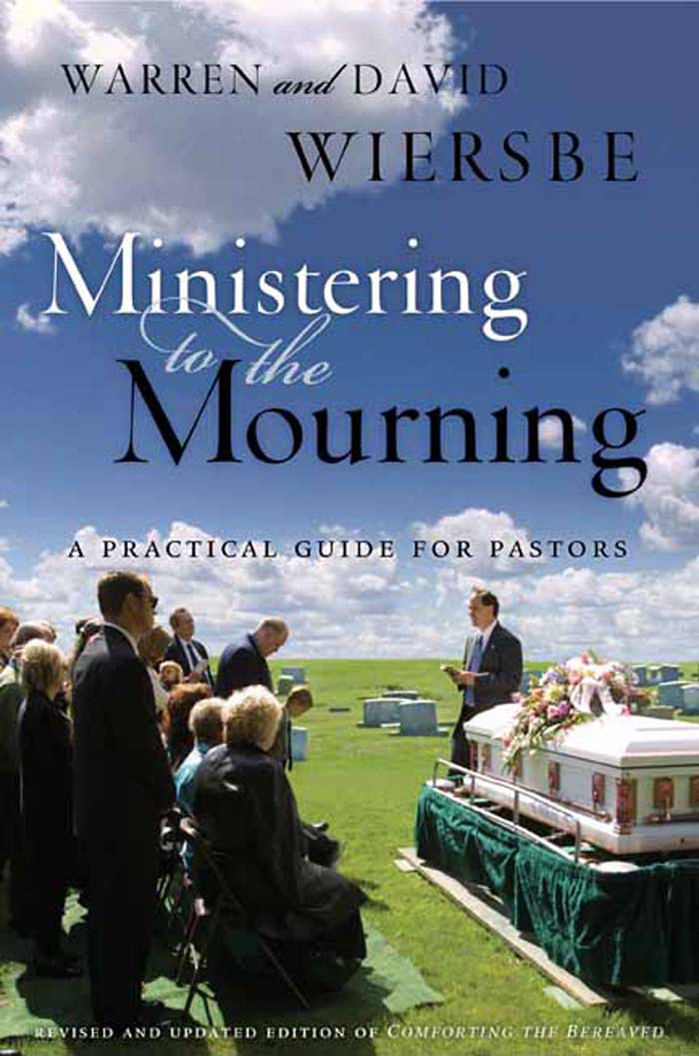Ministering
to the
Mourning
WARREN and DAVID
WIERSBE
Ministering
to the
Mourning
A PRACTICAL GUIDE FOR PASTORS,
CHURCH LEADERS, AND OTHER CAREGIVERS
MOODY PUBLISHERS
C HICAGO
2006 by
Warren W. Wiersbe
David W. Wiersbe
Published previously as Comforting the Bereaved.
All rights reserved. No part of this book may be reproduced in any form without permission in writing from the publisher, except in the case of brief quotations embodied in critical articles or reviews.
All Scripture quotations, unless otherwise indicated, are taken from the Holy Bible, New International Version. NIV. Copyright 1973, 1978, 1984 by International Bible Society. Used by permission of Zondervan Publishing House. All rights reserved.
Scripture quotations marked NASB are taken from the New American Standard Bible, Copyright The Lockman Foundation 1960, 1962, 1963, 1968, 1971, 1972, 1973, 1975, 1977, 1995. Used by permission.
Cover design: Smartt Guys
Image credit: Jim Whitmer
Editor: Betsey Newenhuyse
Library of Congress Cataloging-in-Publication Data
Wiersbe, Warren W.
Ministering to the mourning : a practical guide for pastors, church leaders, and other caregivers / by Warren W. Wiersbe and David W. Wiersbe.2nd ed., rev. and updated.
p. cm.
Includes bibliographical references and index.
ISBN-13: 978-0-8024-1241-6 (alk. paper)
ISBN-10: 0-8024-1241-6
1. Church work with the bereaved. 2. BereavementReligious aspects Christianity. I. Wiersbe, David. II. Title.
BV4330.W545 2006
259'.6dc22
2005037487
We hope you enjoy this book from Moody Publishers. Our goal is to provide high-quality, thought-provoking books and publications that connect truth to your real needs and challenges. For more information on other books and products written and produced from a biblical perspective, go to www.moodypublishers.com or write to:
Moody Publishers
820 N. LaSalle Blvd.
Chicago, IL 60610
1 3 5 7 9 10 8 6 4 2
Printed in the United States of America
Dedication
T o that vast
and growing family of
people who have learned
that Jesus Christ can
heal the brokenhearted,
and who want to share
this comfort with others
who desperately need it.
Contents
Preface to the
Revised Edition
T he first edition of this book, Comforting the Bereaved, was published in 1985 as a concise manual to assist busy pastors and other providers of Christian care as they ministered to people who were sorrowing over the death of a loved one. That the book has remained in print this long shows it was meeting a need, and the generous personal responses of many of the people who used the book have further encouraged us.
Now the time has come for a completely new book that can help provide pastors with the perspectives and principles they need in order to do their jobs more effectively. So many changes have occurred in society and the church, and so much new material has enriched the field of thanatologythat is, the study of death and dyingthat its very difficult to keep current. We have retained and revised some material from the original edition, but for the most part, this is an entirely new book.
Our friend Joe Bayly is now home with the Lord, and we miss him. We have retained the foreword that he graciously wrote for the first edition.
Busy church leaders will be tempted to turn immediately to the practical sections of the book, but we do urge you to read the other chapters as well. It helps the caregiver to have some perspective on how death is viewed in our contemporary world.
The two of us together bring to the writing of this book some eighty years of ministry experience, yet were conscious of how much more could be written. The bibliography will point you to additional resources for your own research. Weve learned that the better equipped pastors are to comfort the bereaved, the better able they are to effectively preach and serve the entire church family. It was Alexander Maclaren, the noted British preacher, who said, If I had to do it over, I would minister more to broken hearts.
That is a good example for all of us to follow.
Warren W. Wiersbe
David W. Wiersbe
A t the beginning of Jesus ministry on earth He quotedand said that He fulfilledthe prophecy of Isaiah 61:1: The Spirit of the Lord is upon me, because he hath anointed me... to heal the brokenhearted (Luke 4:18 KJV ).
Hearts were broken then as hearts are broken now. And a prime sign that the Holy Spirit has anointed His servants (Jesus undershepherds) today continues to be that we bring healing to the brokenhearted.
But it is not an easy part of ministry, especially for the young pastor who has experienced little personal loss. Most of us, professionals and laypersons alike, feel inadequate when confronted by a lifeless body and stunned family. What can we say to parents whose teenage son has taken his own life? whose daughter has died in a car accident? or whose child has been murdered? to the widow suddenly alone after forty years with her beloved companion?
And even before those questions can be answered, what do we know about grief? If we want to bear peoples sorrows, we cannot be ignorant of the forms grief takes.
This book provides biblical, practical answers to those and many other questions that fill the mind confronted by overwhelming loss and grief.
For the pastor, suggestions about visitation, the funeral service (including texts and outlines), and long-term ministry to survivors greatly increase the books value.
One of the most encouraging verses at a time of loss is Isaiah 63:9: In all their affliction He was afflicted, and the angel of His presence saved them ( NASB ).
Through understanding and applying this book, Gods servant may become His angel (messenger) to those who are brokenhearted, saving them from despair.
Thank God a day is coming when tears shall cease and death shall be destroyed.
Joseph Bayly
Death and Contemporary
American Culture
I ts becoming more and more difficult to minister to grieving people, because in their attempts to enjoy life, many of them are denying death. Mention death and the average person responds something like comedian Woody Allen: Its not that Im afraid to die. I just dont want to be there when it happens. There are no funeral homes in shopping malls to remind us of our mortality; and if there were, the salespeople would have to hand out free coffee to keep shoppers from looking the other way. With one hand gripping the steering wheel and the other holding a cell phone, most people breeze their way through the day and never consider that it might be their last.
Ours is a culture that insists that we remain young, no matter how old we are. As for death, dont mention it! We live in a society that invents harmless antiseptic words for deathgoing into the light, passing away, released, and so on. But avoiding the word doesnt eliminate the experience.
The Bible looks death squarely in the face: Yet as surely as the L ORD lives and as you live, there is only a step between me and death (1 Samuel 20:3). A stepnot a mile, not light-years, just a step. The Episcopal Book of Common Prayer burial service puts it this way: In life we are in death. But how many people actually believe this?
This attitude of denial is strange because world events shout death at us day after day. How can we deny death when 2,500,000 people die in the United States each year, and their names are listed in hometown obituary columns? About 13,000 of these people are shotmurderedand another 17,000 deliberately shoot themselves. Sixty million people died in World War II. Over six million Jews died in the Holocaust. Watch the news on television and you may actually see people being burned to death, shot to death, or blown to bits. Let death claim a prominent personPresident Reagan, the Pope, Elvis Presley, or Princess Dianaand the world follows the television reports for days, maybe weeks. As of this writing, lives are being lost in conflicts around the world daily.


